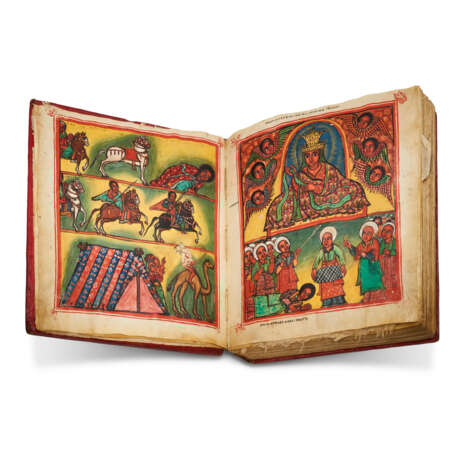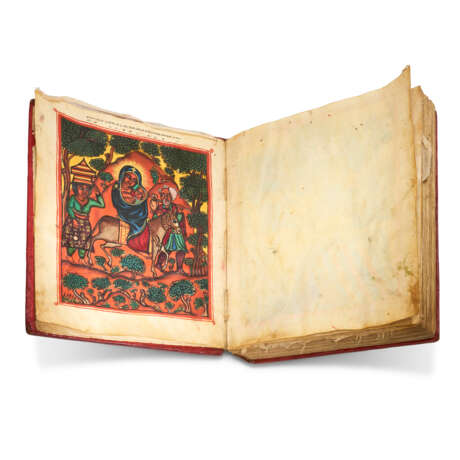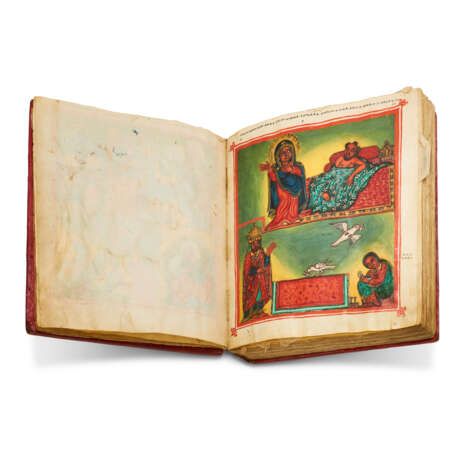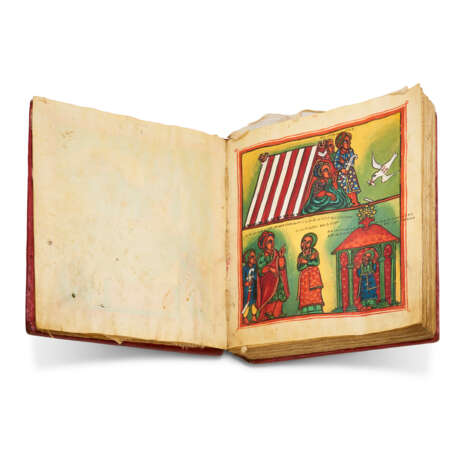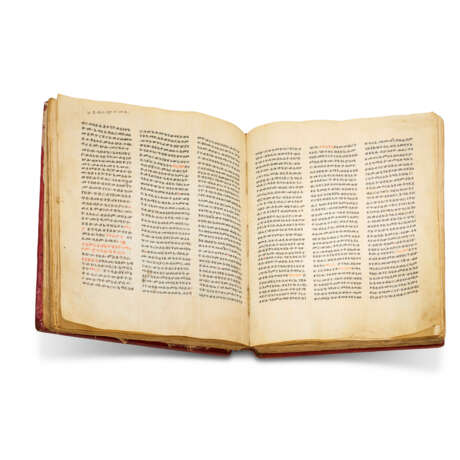ID 1249843
Lot 39 | Second Gondarine style
Valeur estimée
£ 15 000 – 20 000
Miracles of Mary, in Ge'ez, illuminated manuscript on vellum [Ethiopia, early 18th century]
A large, sumptuous, ostentatious illuminated manuscript of one of the most popular devotional Ethiopian texts: an exceptional example of the Art of the Second Gondarine style.
320 x 365mm. 201 leaves, collation: 19 (of 10, ix a stub), 2-310, 410(of 12, iv and viii stubs), 5-610, 711(of 12, ii a stub, xi a single column of text), 88 (of 10, iii and vii stubs), 9-1910, 2011(of 12, v a stub), 214(of 6? ii a stub, lacking end). Three columns of 33 lines written in black ink in several hands in gwelh script (Uhlig’s Period V), ruled space: 255 x 265mm., prickings survive throughout, opening lines, section headings and some names (including the donor’s name) in red, 7 full-page paintings bound at the beginning, most protected by a muslin curtain sewn onto the vellum (probably lacking a miniature after f.8, the final miracle, numbered 300, is incomplete and ends abruptly, f.68 a part leaf containing a single column of text, natural flaws to vellum, contemporary repairs, some cockling and marginal staining, the upper part of the figure on the camel on f.4v scratched out [perhaps a demon?]). Contemporary red morocco tooled in blind (edges a little scuffed). Fitted modern box.
Provenance:
(1) The manuscript does not have a colophon, but the script, which is datable to Uhlig’s Period V (mid 17th – first half of the 18th century), displays a number of features which when taken together with the style of the illumination, indicate a date in the first three decades of the 18th century. Invocations for blessings at the end of each miracle, as well as in the introduction to some of the miracles, contain the names of a certain Gälasyos (or Gälaséwos), and Abunä Oryarés, the title ‘Abunä’ here referring to a senior cleric and not the Head of the Ethiopian Church. The name Oryarés occurs with greater frequency in the first third of the manuscript. Both names appear to have been inserted at the time of composition. On f.69v, at the end of Miracle no 64, the name T’a‘emä Krestos has been inserted in the closing invocation.
(2) Sam Fogg, 1999.
Content:
Blank ff.1-3; full-page miniatures ff.3v-9v (see subjects below); Preamble to the Miracles of Mary, known as the Mäs’hafä Ser‘at, beginning: ‘In the name of the Father, and of the Son, and of the Holy Ghost. One God. Amen. This is the book which issued from the See of Mark the Apostle, from the place of Mä‘alqa in Egypt, and which the teachers of the Christian Church, the reverend archbishops, learned in mysteries and righteous of faith, compiled and which Our Lady Mary dictated to them’ ff.10-11; a sälam to the Virgin Mary, in a different hand, ff.11-11v; Miracles of Mary (the last miracle, numbered 300, is incomplete) ff.12-199v; blank ff.200-201.
There are 306 Miracles in the present manuscript, although the numbering in the text identifies only 300. There are 7 unnumbered miracles at ff.92-95, identified with a red line framing the text: there is no obvious textual or thematic reason for this. The sequence also omits number 108.
The original 'canon' contained 33 miracles, but even before the growth of the cult of the Virgin Mary in Ethiopia in the 15th century, numerous additions had been made to the Arabic Vorlage of the Ethiopian text. The largest known collection is British Library Or. 643, dated 1717, and containing 316 miracles - only 10 more than the present text. Smaller collections are more common both in institutions and on the market. The essential reference book on the Ethiopian Book of the Miracles of Mary is E, Cerculli Il libro etiopico dei Miracoli di Maria, 1943; see also E.A. Wallis Budge, The Miracles of the Blessed Virgin Mary and the Life of Hanna, London 1900, and One Hundred and Ten Miracles of Our Lady Mary, 1933.
Illumination:
The 7 full-page paintings are a splendid example of the Second Gondarine style. The reigns of Tekle Haymanot I (1706-8) and later successor Dawit (1716-21) marked a key moment in the development of Ethiopian art, when the First Gondarene style of the 17th century was gradually replaced by the court painting style that dominated throughout the 18th century. This moment of transition is evident in the present manuscript: we see a marked departure from the earlier style related to icon painting, and a synthesising of new ideas of surface and space. Though not quite as refined, the style is reminiscent of that of the Miracles of Mary commissioned by King Tekle Haymanot I, later in the collections of William Randolph Hearst and Otto Schaefer. Each painting is framed in a double red line, and is described by an accompanying text placed in the margin above or within the painting itself. Most of the paintings contain two or, in one instance, three distinct scenes represented in panels, one above the other.
The subjects of the full-page paintings are as follows:
f.3v: The Flight into Egypt
f.4v: three panels with StsTheodore the Oriental and George; Theodore, Claudius and Mercurius; and a tent, figures and a camel.
f.5: two panels with Mary appearing in glory at Mt. Mitmaq; and the donor Gälasyos prostrating himself before a group of clerics (däbtära).
f.6: two panels with Mary, seated, presenting a book and a garment to Dexius; and Dexius writing, while an angel hovers over him with a drawn sword.
f.7: two panels with Mary appearing before the sleeping Caliph; and the Caliph and his scribe, with the Holy Spirit hovering above.
f.8: two panels with a dove bearing a scroll landing before the Caliph’s officers who stand outside a tent; and three scenes each identified by text i) the Caliph’s officer who was commanded to demolish the churches; ii) the priest John sending a messenger to the Caliph’s officer; iii) the Virgin Mary assisting the priest John in preventing the churches from being demolished.
f.9: two panels with the Bishops Theophilus and Timothy writing about the Miracles under the Virgin Mary’s direction; and Abba Antonius writing.
| Lieu d'origine: | Afrique |
|---|---|
| Catégorie maison de vente aux enchères: | Manuscrits médiévaux et de la Renaissance, Livres et manuscrits |
| Lieu d'origine: | Afrique |
|---|---|
| Catégorie maison de vente aux enchères: | Manuscrits médiévaux et de la Renaissance, Livres et manuscrits |
| Adresse de l'enchère |
CHRISTIE'S 8 King Street, St. James's SW1Y 6QT London Royaume-Uni | |
|---|---|---|
| Aperçu |
| |
| Téléphone | +44 (0)20 7839 9060 | |
| Commission | see on Website | |
| Conditions d'utilisation | Conditions d'utilisation |
